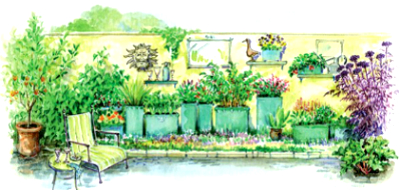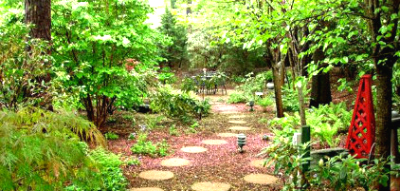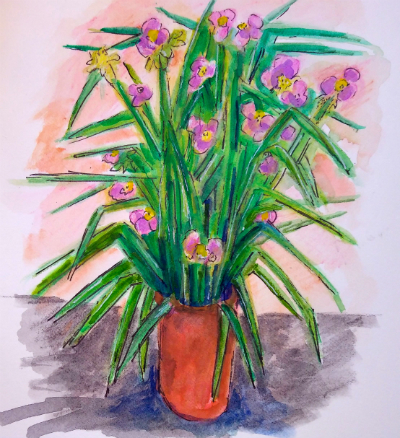
bringing nature, nurseries and gardeners together April 2, 2020
|
|
As Nature applies the brakes to planet earth in the form of Covid-19, gardeners can at least count a few blessings during this dark time. A sanctuary, a resource for fresh, organic food, a place to play frisbee with the kids, somewhere for alone-time away from the family... the benefits are many. However shopping for the garden continues to be a challenge.
Barton Springs Nursery: closed
The Natural Gardener: closed
The Great Outdoors: Curbside pick-up and Delivery
Shoal Creek Nursery: unknown
Wimberley Gardens: open 9 - 3 p.m. Ten people allowed in at a time, 6 feet apart. Call the nursery 512 842 1220 to create a 'no contact' to-go order. ❦

Groundbreaking food garden designs: Growing your own vegetables in your garden doesn’t mean you have to sacrifice design, writes Genevieve Schmidt. Checker boards, cocktail gardens and courtyards are all possibilities. Garden Design ❦

Let Nature be your refuge: 'Reconnecting with the natural world – however we can – is a wonderful medicine against anxiety and fear,' writes Lucy Jones. Relaxation, stress reduction and awe can greatly enhance our immune system, she writes. The Guardian ❦
_________________________________________________
New owner for EZ Herbs: congratulations to Corey Gusnowski who is taking over the leadership of this purveyor of fine herbs as Ellen Zimmerman retires. EZ Herbs ❦

Easy DIY plant markers: you can easily re-purpose wine corks, broken shards of pottery, paint stirrers and clothespegs, and turn them into 'trendy plant markers,' writes Jill Spencer.
_________________________________________________
a d v e r t i s e m e n t
Thursday Morning Landscape
design and installation,
free consultation Call Dwight: 512 913 2189
_________________________________________________
Central Texas Gardener: native fruit trees are the focus of the in-studio guest Karen Beaty (Wildflower Center). On tour, UT students are creating a patch of Blackland Prairie on-campus at the Half-Pint Urban Prairie. Sat. 4 p.m. Sun. 9 a.m. KLRU ❦

Spiderwort Bouquet: an original illustration by Linda Anderson
8 April Projects for Gardeners
by Chris Winslow
1. Spring vegetable gardening: Plant those warm season crops. This list includes beans, black-eyed peas, okra, squash, cantaloupe, tomatoes, peppers, cucumbers, watermelon, corn, and eggplant. There's still time to plant those cooler season crops: lettuce, radishes, and carrots.
2. Fertilize your garden: Do this organically with compost. Other sources of nutrition are dried fish flakes and organic fertilizers formulated for garden use. You can also use liquid fertilizers, such as fish emulsion and seaweed extracts.
3. Control weeds: Keep them down with mulch and by weeding a little bit every day.
4. Plant spring annuals: This is the perfect time. Work some compost into your flower beds and you'll give these new plants just the food they need to flower through the summer. Some ideas: begonias, zinnias, marigolds, petunias, coleus, periwinkle, cosmos, larkspur, portulaca, and purslane.
5. Plant perennials: Choose some of your favorites from the extensive lists available, or visit your neighborhood nursery and browse. Look for the many varieties of drought tolerant and showy lantanas and salvias. Also blackfoot daisies, skullcaps, purple coneflowers, black-eyed Susan, plumbagos, columbines, rockrose, ruella, and verbena.
6. Ornamental grasses: Native varieties are best due to their heat and drought tolerance. My favorites are big muhley, coastal muhley and the maiden grasses. For a short grass in a very dry place, you might like Mexican feather grass. It is blond-colored, reaches 1.5 foot in height, and makes a beautiful accent plant that moves so gracefully with the slightest breeze.
7. Fertilize lawn: Use a slow release organic fertilizer. The 3-1-2 ratio is best. Allow 10 pounds of fertilizer for every 1,000 square feet of lawn. Mowing height should be 2.5 inches for St. Augustine grass and 2 inches for Bermuda and zoysia. I like to return the grass clippings to the turf. These clippings act as a mulch and help to reduce weeds. Water infrequently and deeply to encourage a deep root system. This practice will train your lawn grass to be more drought tolerant and help to conserve water.
8. Fertilize shrubs, trees: Mulch with a compost-mulch blend to provide nutrients and conserve water. Deep, infrequent watering of shrubs and trees will encourage deep, drought-tolerant root systems. Remember to seal pruning cuts on oak trees. It might save them from oak wilt. Happy springtime gardening everyone! ❦
|
 It's About Thyme Legacy Publications.
Contact newsletter editor Darrel Mayers with any ideas for articles or interesting links at internationalrain@yahoo.com (hitting 'reply' to this email won't work) |
|
|